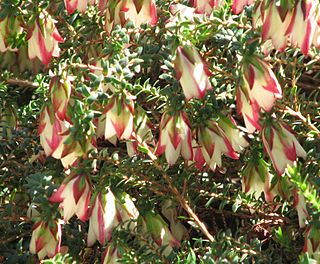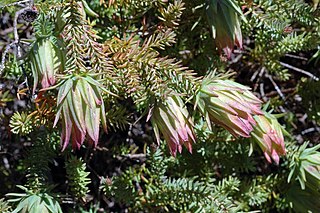Banksia tortifolia is a small, spreading, prostrate shrub that is endemic to the southwest of Western Australia. It has short underground stems, pinnatipartite leaves with sharply-pointed, linear lobes on each side, greenish-cream, yellow and pink flowers in heads of about eighty, and glabrous, egg-shaped follicles.

Darwinia macrostegia, commonly known as Mondurup bell, is a species of flowering plant in the family Myrtaceae and is endemic to the south-west of Western Australia. It is a straggly shrub with elliptic leaves and clusters of pendent flowers surrounded by red and white bracts.

Darwinia citriodora, commonly known as lemon-scented darwinia or lemon scented myrtle, is a plant in the myrtle family Myrtaceae and is endemic to the south-west of Western Australia. It is a shrub with oblong to lance-shaped leaves and red, yellow and orange flowers over an extended period. It is a hardy plant in well-drained soil, is often cultivated and used as a rootstock for less hardy species.
Verticordia verticordina is a flowering plant in the myrtle family, Myrtaceae and is endemic to a small area near the coast of the south-west of Western Australia. It is a small, low-growing shrub with crowded leaves and in spring, scattered pale greenish-cream and golden brown flowers. Its unusual flowers and fleshy leaves give the plant a superficial resemblance to a Darwinia.

Darwinia leiostyla is an erect shrub in the family Myrtaceae and is endemic to the south-west of Western Australia. It typically grows to a height of 0.3–1.5 m and has linear leaves up to about 10 mm (0.39 in) long crowded along the branches. Pendent, bell-shaped, flower-like inflorescences appear from May to January. These are clusters of small flowers surrounded by larger pink, red or white, petal-like bracts.

Darwinia hypericifolia is a species of flowering plant in the myrtle family Myrtaceae and is endemic to the south-west of Western Australia. It is an erect, straggly shrub that typically grows to a height of 0.4–1 m and has clusters of flowers surrounded by red bracts, mainly in October and November.

Darwinia micropetala, commonly known as small darwinia, is a species of flowering plant in the family Myrtaceae and is endemic to south-eastern continental Australia. It is a small, erect shrub with linear leaves, and heads of white to pink flowers.

Darwinia diosmoides is a species of flowering plant in the myrtle family Myrtaceae and is endemic to the south-west of Western Australia. It is a dense, erect shrub with linear leaves and more or less spherical heads of white flowers.

Darwinia virescens, commonly known as Murchison darwinia, is a species of flowering plant in the family Myrtaceae and is endemic to a small area on the west coast of Western Australia near Geraldton. It is a prostrate or low-lying shrub with crowded linear leaves and dense, hemispherical heads of green, yellow or red flowers.

Darwinia oederoides is a species of flowering plant in the family Myrtaceae and is endemic to the south-west of Western Australia. It is a low, spreading shrub with linear leaves and clusters of pendent flowers surrounded by red and yellow bracts.

Darwinia oldfieldii is a species of flowering plant in the family Myrtaceae and is endemic to Western Australia. It is an erect, spreading shrub with oblong leaves and dense heads of erect, red flowers.

Darwinia pauciflora is a species of flowering plant in the family Myrtaceae and is endemic to the southwest of Western Australia. It is an open to bushy shrub with oblong to egg-shaped leaves and heads of erect, creamy-white and pink flowers.

Darwinia pimelioides is a species of flowering plant in the family Myrtaceae and is endemic to the southwest of Western Australia. It is an erect shrub with broadly oblong leaves and heads of drooping flowers surrounded by larger red to pink and green bracts.

Darwinia pinifolia is a species of flowering plant in the family Myrtaceae and is endemic to the southwest of Western Australia. It is a low, spreading to prostrate shrub with linear leaves and dense heads of erect, red to purple flowers.

Darwinia purpurea, commonly known as the rose darwinia, is a species of flowering plant in the family Myrtaceae and is endemic to the southwest of Western Australia. It is a spreading shrub with linear leaves and dense heads of red or yellow flowers surrounded by many overlapping involucral bracts.

Darwinia sanguinea is a species of flowering plant in the myrtle family Myrtaceae and is endemic to the south-west of Western Australia. It is a prostrate, sprawling shrub that typically grows to a height of 5–20 cm (2.0–7.9 in) and has reddish purple flowers between August and December.

Darwinia speciosa is a plant in the myrtle family Myrtaceae and is endemic to the southwest of Western Australia. It is a dwarf, spreading or prostrate shrub with narrowly oblong leaves arranged in opposite pairs, and greenish flowers surrounded by larger dark red or brownish involucral bracts.

Darwinia thymoides is a species of flowering plant in the myrtle family Myrtaceae and is endemic to the south-west of Western Australia. It is a low, spreading to prostrate shrub with linear to lance-shaped leaves and groups of 4 to 8 green, red or white flowers surrounded by leaf-like bracts.

Darwinia vestita, commonly known as pom-pom darwinia, is a species of flowering plant in the family Myrtaceae and is endemic to the southwest of Western Australia. It is an erect, bushy shrub with crowded egg-shaped, oblong, or linear leaves and more or less spherical heads of white to reddish-pink flowers.

Styphelia glaucifolia is a species of flowering plant in the family Ericaceae and is endemic to the south-west of Western Australia. It is an erect or spreading shrub with linear, sharply-pointed leaves, and white, tube-shaped flowers.



















